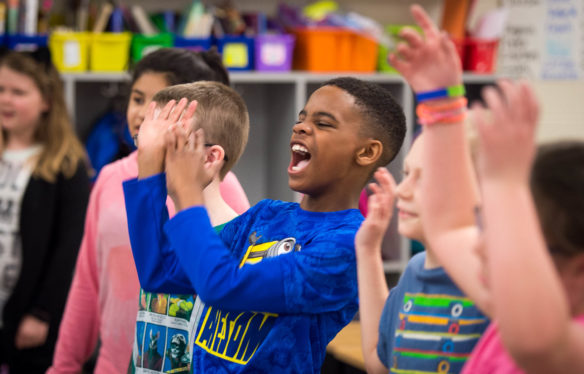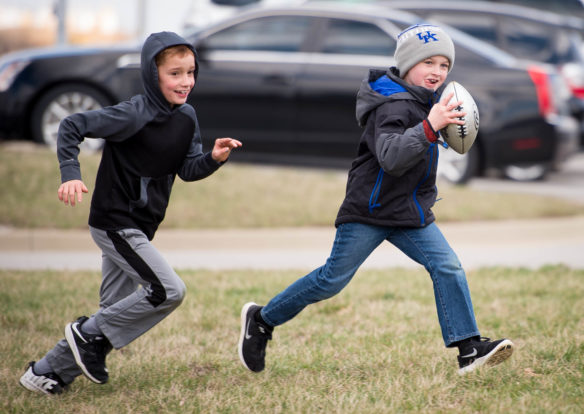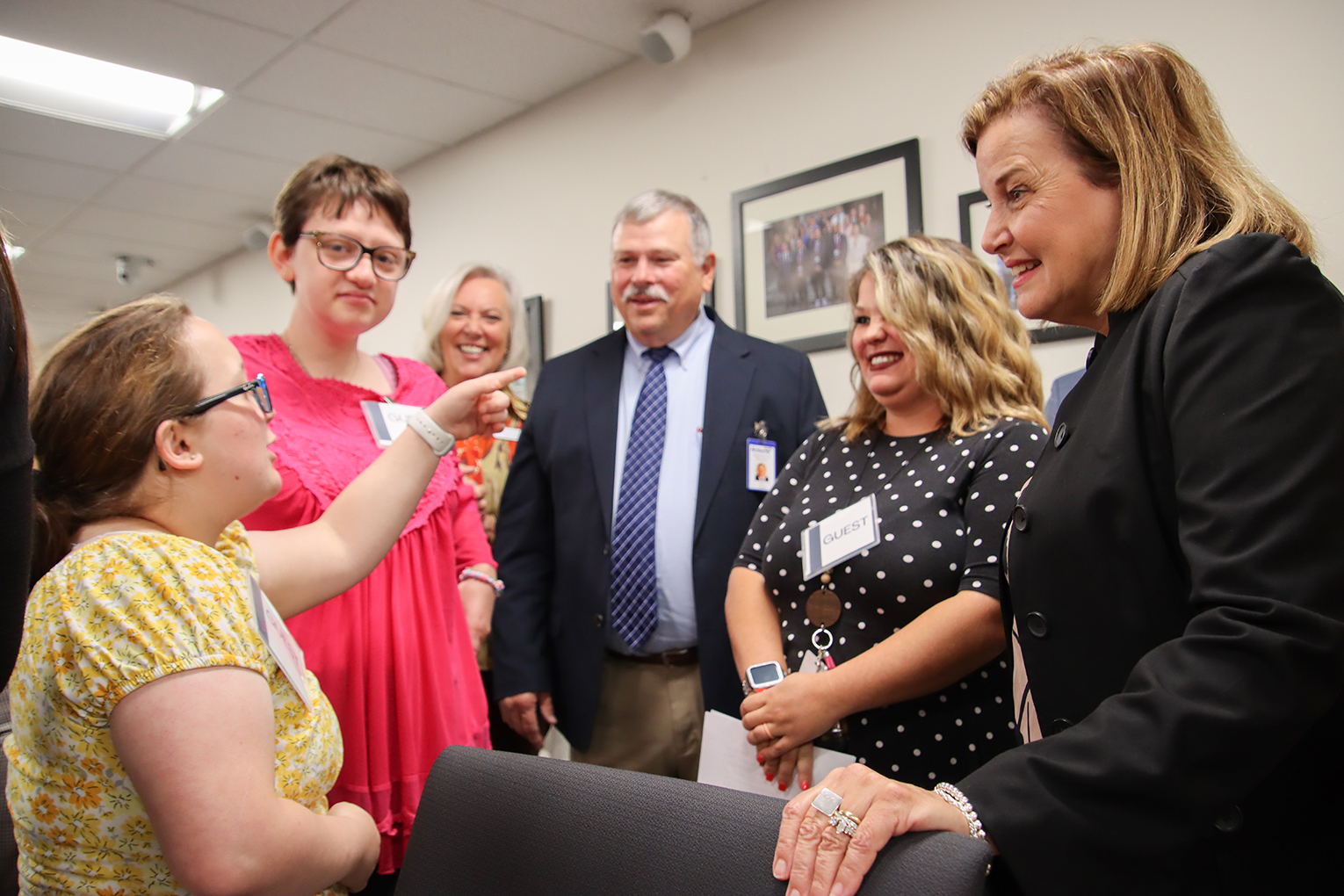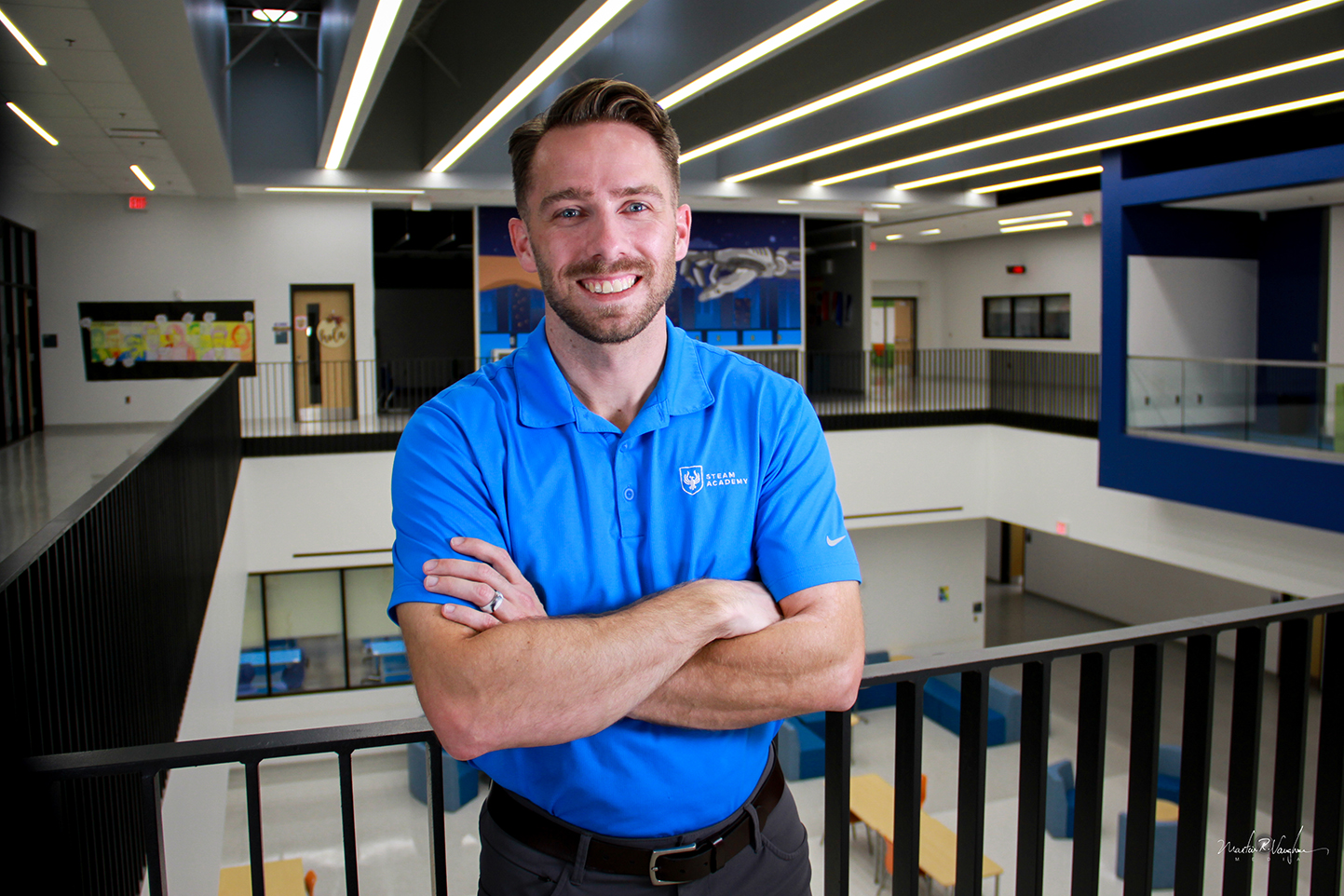
Owen LauBach, a 3rd-grader at Lemons Mill Elementary, counts out loud with his class during a GoNoodle video as part of a second recess the school added this year. Teacher say that although they’ve lost 10 minutes of instructional time each morning, the students are more focused and ready to learn.
Photo by Bobby Ellis, March 3, 2017
By Audra Deli-Hoofnagle
audra.deli-hoofnagle@education.ky.gov
“Where am I going to find the time,” thought Chrissy Ellison, a 3rd-grade teacher at Lemons Mill Elementary (Scott County) when she was told the school was going to offer students an extra daily recess. The master schedule already had been completed for the next school year and the 2016-17 school year was weeks away from beginning.
Principal Lori Beth Mays has been participating in the University of Kentucky’s Next Generation Leadership Academy, which focuses on getting input from students about what they want their school experience to be like. Mays decided to survey teachers about classroom scheduling and procedures. She had no idea what the results were going to show.
“We knew we wanted to make a change. At the same time, our physical education teacher, Sara Jill Handy, was digging deeper into our school’s health and wellness policy,” Mays said.
A staff survey delving deeper into how much physical activity time students received each day revealed some startling results, Mays said.
“Honestly, it saddened me to see that 50 percent of our students received less than 20 minutes of physical activity per day,” she said. “After seeing those results, I felt a sense of urgency.”
Mays decided it was time to dig deeper. She and the school’s Academic Dean, Jamie Hockensmith, developed a plan of action.
In March 2016, Mays and her staff interviewed about 150 of the 640 students. They asked questions about what students wanted to do differently at school. Mays said there was an overwhelming response from students.
“It was obvious they wanted to move more!” she said.
And studies show that moving more benefits student in numerous ways. Children and adolescents should do 60 minutes or more of physical activity each day according to the Centers for Disease Control and Prevention.
To make sure the teachers were on board with the idea of adding more recess time to the regular school day, 25 students participated in a schoolwide staff meeting.
“I knew that the staff needed to hear that from the students,” Mays said. “I could easily tell them to do something, but they would not have as much buy-in if it was just coming from me. Teachers had a lot of takeaways that day, but the biggest was, our kids need to move.”

Zyler Housekeeper and Jake Hall play football during a recess at Lemon’s Mill Elementary. Principal Lori Beth Mays said educators at the school worked hard to find a way to add extra recess time to the day this school year after a staff survey showed that 50 percent of students received less than 20 minutes of physical activity per day.
Photo by Bobby Ellis, March 3, 2017
Teachers were asked to work together and schedule an extra recess in the morning, even though the approved master schedule had time for one afternoon recess. Fourth-grade teacher Tabetha Housekeeper said finding the time was not an easy task.
“It’s not just 10 minutes of play,” she said, “it’s lining up, walking outside, letting students play for 10 minutes, then lining back up and walking back. That can be up to 20 extra minutes a day and our schedule is already very structured.
“However, it was a no-brainer to me. I had to listen to our students. They are our clients and we work for them. If they tell us they need it, we need to provide it.”
To accommodate an extra 10 minutes of morning recess, some teachers use the playgrounds while others use free space outside that is closer to their classrooms.
“You don’t have to be on a playground to take a movement break,” Housekeeper said. “We go right outside our classroom and save time by not walking clear across the building. We don’t really need any equipment to let our kids move.”
On cold and rainy days, outdoor recess is at the teacher’s discretion.
“We go out unless it’s under 32 degrees or raining,” Ellison said. “I firmly believe fresh air does a lot for students. On rainy days, we usually do a GoNoodle break, followed by 5 minutes of student choice.”
Housekeeper said she has recess in her classroom if the temperature reaches 35 degrees.
“We always begin with a movement, so students can choose something like a Just Dance on YouTube. From there, usually the star student of the week decides on a collaboration or cooperation activity,” she said. “Students usually ask to end with some movement, like a GoNoodle, before we begin class work, and I usually will allow that.”
Ellison said that even though she’s lost 10 minutes of her instructional day, the time she has is better because her students have had more time to move.
“I’ve lost the quantity of instruction, but I have upped the quality of learning in my classroom,” she said. “When students return from recess, they are so much more attentive, ready to listen and work, on task and following along. It is probably one of my best teaching times of my day.”
The extra recess time also have provided some unexpected benefits in Handy’s physical education classes.
“Students have a better experience in my classroom now because they get to play together more outside of the gym.,” she said. “Socially, they are working together so much better.”
Mays says that the biggest gain she can see from implementing the extra recess is in instruction.
“Teachers are able to cover so much more content because they are not redirecting students so often,” she said. “Students are focused, more engaged and the relationships in their classrooms are stronger. Adding the extra recess in the morning has made huge gains for our school.”



Leave A Comment